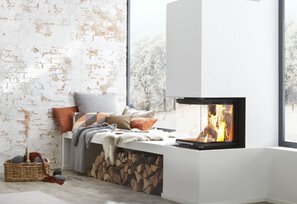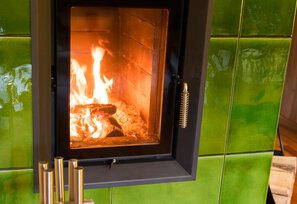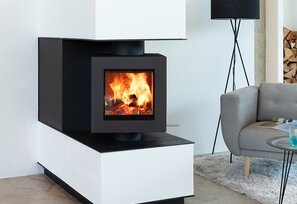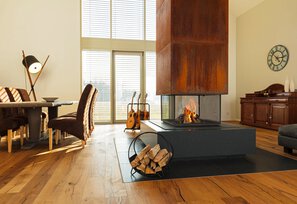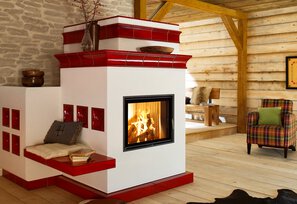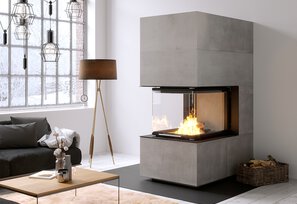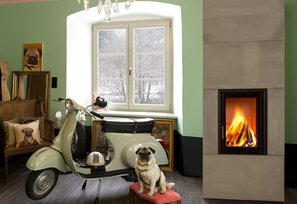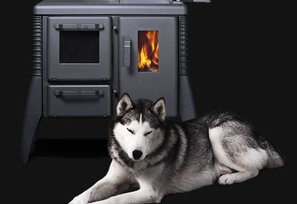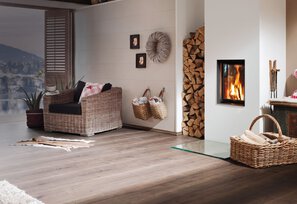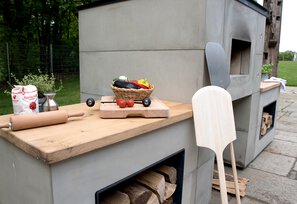Air
A distinction is to be made between primary and secondary air during combustion. The term primary air refers to the combustion air that is required for wood combustion. The term secondary air describes the combustion air that is required for the post-combustion of flue gases.
Boiler technology
In boiler technology, combustion chamber radiation and energy from the heating gases can be fed directly to a central heating system via boiler surfaces in wood stove systems. Indirectly heated boiler surfaces, which absorb heat by means of chamotte layers, do not need to be cleaned. Soot deposits should be regularly removed through the cleaning openings on boiler surfaces where heat is transferred directly by the conveyed heating gases.
Buffer storage unit
A buffer storage unit is the "storage medium" of a heating system. It can be both an insulated water container and a solid mass body. The heat storage unit absorbs too much of the released energy for the moment, which can be specifically retrieved from there at any time. In this way, the buffer storage unit balances out contrasts between the heat output generated and the heat output currently required.
Calorific value
The calorific value determines which benefit (= amount of heat in kWh) can be achieved during combustion. Due to its higher resin content, coniferous wood has a higher calorific value of around 5.2 kWh/kg dry matter than hardwood (5.0 kWh/kg). But these values have no influence on the calorific value; as to this, residual moisture - i.e. the amount of water still present in the wood - plays a more significant role. Freshly cut hardwood, for example, has a 50% water content and a calorific value of only 2.1 kWh/kg. For comparison: Air-dried wood has a calorific value of 3.0 to 4.5 kWh/kg, depending on the storage period.
| Water content g/kg Wood | Calorific value kWh/kg | |
| Wood, very dry | 100 | 4,5 |
| Wood, stored for two years | 200 | 4 |
| Wood, stored for one year | 350 | 3 |
| Wood, freshly cut | 500 | 2,1 |
With an average heat demand of 4 kW, the amount of heat required per day (4 kW x 24 hours) is 96 kWh.. If this heat is provided by burning well-stored wood, one cubic metre of renewable combustible material will be sufficient for 21 days. If, instead, freshly cut wood is used, one cubic metre will only last for eleven days.
Cast iron
Cast iron has always been one of the high-quality materials for the manufacture of firing systems. It is mainly used for components that need to be particularly sturdy and durable. The main difference to steel is the high proportion of carbon (> two percent). Cast iron stretches and contracts less than steel; it has significantly less scaling and the fits are much more precise.
Central heating system
Use regenerative energies and reduce the use of fossil heat carriers as much as possible: With BRUNNER central heating system (BCH), your heating system becomes an intelligent heating system.
We have incorporated our decades of experience, the wishes of our customers and trade partners as well as the latest technical developments into the design of the BRUNNER central heating system. The result is a convertible and expandable system that intelligently controls modern heating. A heating system of the future.
DETAILS
Construction:
The idea behind BRUNNER's central heating system was to develop an effective and, above all, easy-to-use heating solution that centrally controls all the components of a modern heating system. The result is a system that efficiently connects different heat generators and integrates them according to eco-hierarchical principles.
-Modular, clean and space-saving design
-Heat generators and utilities ready for plug-in connection
-Functional guarantee: No hydraulic installation errors possible
-Equipped for the future: Convertible and expandable at any time

The system storage unit can also be installed under a staircase to save space. The hydraulic box is located in the boiler room and the control unit in the entrance area.
Hydraulic box:
At BRUNNER, under hydraulic box, we mean the coordinated, compact basic installation of all technical components that are necessary for a buffer-storage-based heating system. In other words, the perfect interplay between generating, collecting and distributing heat.

Neatly packed into the smallest of space: The hydraulic box measures only 108 x 40 cm - all connections for heat generators, heating circuits or hot water systems are accommodated in a space-saving and clearly arranged manner behind its housing.

1.1 Cold water
1.2 Circulation
1.3 Hot water
2.1 Return line of solar thermal system with system separation*
2.2 Supply line of solar thermal system with system separation*
3.1 Solid fuel boiler supply line
3.2 Solid fuel boiler return line
4.1 Heating circuit 1 return line
4.2 Heating circuit 1 supply line
5.1 Heating circuit 2 return line
5.2 Heating circuit 2 supply line
The hydraulic register works like a power strip for thermal connections.
(* solar thermal system optionally with/without system separation)

HEAT SOURCE SOLID FUEL BOILER
- Integrated return line boost
- Integrated output measurement for solid fuel boilers

HOT WATER UTILITY
- Fresh water module with plate heat exchanger
- Alternatively, adjacent hot water tank

ELECTRONICS
The control box with the main circuit board, which is protected against moisture, is located in the cool floor area. All sensors and control lines of the heat generators and utilities are ready for plug-in connection. A bus line leads to the display.

HEAT SOURCE SUN
- Solar thermal systems with system separation (plate heat exchanger)
- Solar thermal systems without system separation
- Integrated output measurement for the solar thermal system
Illustration: Plate heat exchanger without insulation shell OTHER HEAT SOURCES Side connection of oil, gas, electricity, heat pump, other heat generators HEATING UTILITIES Up to two controlled heating circuits, suitable for radiators, wall heating, underfloor heating, other commercially available heating systems Cladding: the front cladding of the BRUNNER central heating system is made of powder-coated steel plate.


The upper part of the cladding can be opened and locked in the open position. The front element underneath can be removed from the front. This makes all parts of the hydraulic box easily and quickly accessible. The rear and side walls are also made of steel plate and bolted directly to the register frame.

The hinged and removable cladding elements of the hydraulic box.
Energy-saving pumps:
Energy-saving pumps (manufactured by Wilo) are used throughout BRUNNER's central heating system, in compliance with the ErP directive for resource protection. The models are speed-controlled and particularly powerful. In the solid fuel boiler and in the domestic hot water circuit, the pumps are controlled directly and based on demand through the PWM signal; in the solar circuit, classic regulation through phase angle control is used.
Integration of the BRUNNER heat pump:
a BRUNNER heat pump can be fitted into the BRUNNER central heating system. The 750 or 1000 litre system cylinder from BRUNNER is designed to cope perfectly with the high volume flow rates of a heat pump.
Modular design:
The modular design of the central heating system from BRUNNER makes it possible for you to customise heating to your personal living situation. Only the currently required version is ordered and purchased. The hydraulic box can be expanded directly at the customer's premises, with little assembly work, at any time. Our idea was to develop a future-proof hybrid heating system that smartly couples various heat generators. The control software specially designed by BRUNNER is modified on a permanent basis and can be updated quickly and easily.

Existing heating system with a heating circuit and hot water storage/loading tank.

The solar thermal system and a second heating circuit are retrofitted.

The old hot water tank is calcified.
The DHW heating system is renovated with a fresh water module.

Extension with a third and fourth heating circuit.
Accessories: BRUNNER heating circuit pump groups with distribution board.
Heating circuit extension:

Two outdoor temperature-controlled heating circuits are located inside the hydraulic box.

The third and fourth heating circuits are fitted outside the hydraulic box.

Scheme 1: BCH with third and fourth heating circuit through variant with heating circuit extension.
Accessories: Extension board for "heating circuits"; distribution board and hydraulic group for "heating circuits".
OPERATION
Finally, a heating system you can understand:
Ingeniously simple - simply ingenious: There is no more easily understandable heating operation than that of the BRUNNER central heating system. The BCH is centrally controlled through a single graphic user interface. The most relevant information can be immediately acquired, all settings can be made logically and in a clearly understandable manner. The information dialogue boxes speak your language and use as little technical terminology as necessary. If a second display is placed in the living room or entrance area, you can set and operate the heating where you live.
Online access to your heating system:
By registering your personal BRUNNER system at www.mybrunner.com, you can access your own heating system through the internet from any smartphone or tablet. This allows settings to be made, information to be called up and current operating states to be viewed from anywhere in the world.
Structure of the touch display:

-Start page: the system overview
-Detailed information of the heat generators and utilities involved can be called up
-System settings for the craftsman or customer service
-Help with current screen display or system messages
-Line sections are shown in red during heat transport
-Temperatures of heating circuit supply lines and information on current heating programme - Touching the corresponding section takes the user to the respective heating circuit menu.
-For the variant with hot water tank: Information on the temperature level and hot water programme
-Display of the heat supply in the system storage unit
-The outdoor temperature
-Operating status of auxiliary heating; detailed information can be called up
-Solid fuel boiler temperature or output
-Current output of the solar heating system: Entering the "Solar" menu
Display views:

The display has a simple and intuitive user interface. Even for the layman, all levels and settings can be logically operated - for example by entering and changing the heating programmes. Briefly tap on the desired heating circuit and the corresponding menu will appear.

In addition to information on the selected heating system, the heating programme
can be called up with the corresponding button.

The heating availability times are displayed in a timetable.
Heating operation is reduced in the time windows highlighted in grey.

The heating schedule can be adapted to personal needs.
The heating is activated during the times highlighted in orange.

The new heating programme is saved under its own name.
In the same way, hot water availability times can be reduced,
circulation and other heat generators can be set in the same way.

Knowing where the heat comes from: Just touch the buffer storage unit and
the heat balance of the heating system with heat generators Solar,
the split logs and auxiliary heating oil boiler will be visible.

Graphic recording of all sensors of the solar system included
Power measurement; easy to read on the BCH display.

What does your personal energy mix look like?
A tap on the buffer storage unit provides the answer.

“Solar" menu: The history of solar yields presented in graphical form.

Selection for temperature-optimised or yield-optimised solar control.
PHOTOVOLTAIC INTEGRATION
The first real integration of solar power into a heating system:
Reimbursements for self-generated solar power are getting lower and lower, while electricity prices for private use continue to rise. Owners of PV systems are looking for new ways to use the surplus solar power sensibly and to integrate it efficiently into the heating systems.
The BRUNNER solution as another module of the BCH strictly stratifies the solar yields; even with low solar radiation. No additional auxiliary energy is required to store the excess solar power, for example by means of pumps. Radiation losses caused by external components are also not given. In the case of higher or longer lasting solar radiation, a speed-controlled high-efficiency pump in BRUNNER central heating system ensures reliable stratification of the system storage unit. With a 0,1 to 9 kW continuously controlled heat output, excess solar power yields are stored at usable temperature levels in the buffer storage unit. As a result, high or even predominantly solar fractions of coverage are ensured. This power control meets all requirements of the technical connection conditions from German grid operators and energy providers.
Both customers and heating engineers can take advantage equally from the benefits of photovoltaic integration. The result is an optically and technically flawless built-in boiler room at the same cost as a conventional installation. Despite its complexity, the BRUNNER heating system can be easily operated through and understood by a single control unit - the basis for effective operation. At the same time, the desire for a rational use of the surplus solar power is professionally taken into account. All BRUNNER heating systems come with a functional and future guarantee.
The pre-assembled hydraulics prevent installation errors and any functional impairment due to mismatched components or different controllers. With the BCH, the handicraft industry can offer the end consumer a new, reliable solution for the use of excess solar energy. The interfaces of the heating trade to the electrical trade are also clearly streamlined and defined.

Converting solar power into heat can be so simple. The BRUNNER central heating system has been awarded the Innovation Prize and the Bavarian State Prize of the Ministry of Economic Affairs for the sensible integration of surplus solar electricity in usable temperature levels without provision losses and auxiliary energy requirements. Furthermore, heating optimisation with a BCH is generously subsidised by BAFA, the Federal Office for Economic Affairs and Export Control (Bundesamt für Wirtschaft und Ausfuhrkontrolle).
Converting solar power into heat:

Solar power yields supply household utilities. The surplus is used for heating. An electrical heating element in the system storage unit heats the upper storage area. Due to continuous output control, 0.5 to 9 kW solar power can be used for heating. Thus, the photovoltaic system can leverage a long-term additional benefit irrespective of legal regulations.
Use all storage areas for power yields:

In the stratified hot water storage tank, the electric heating element is installed in the upper temperature zone of the buffer. In order to utilise the entire volume as a "thermal battery" for power yields, special hydraulics are used in the fresh water module. The stratified charging pipe pumps the hot water from the upper storage unit area into the appropriate temperature zone, until the entire storage unit is hot. In this way, all storage areas can be used for power yields.
When and in which combination electricity from the PV system and the grid is used can be set individually:
- Heat feed-in according to supply - only surplus heating electricity is used for heating.
- Heat feed-in according to demand - the electric heater is primarily photovoltaic-operated. If the amount of heat is not sufficient, power is supplemented from the grid.
EMERGENCY POWER SUPPLY
Brunner emergency power supply NV 500/1000 in a free installation

supplies the boiler with the necessary electrical voltage for controlled combustion.
Brunner emergency power supply NV 500/1000 in combination with BRUNNER central heating system

additionally supplies the heating circuit pumps for trouble-free operation of the central heating system.
If power fails, combustion continues in a split log boiler, but in this case the hot water is no longer discharged through the buffer charging pump. To prevent excessive pressure in the boiler, cold water is supplied by means of a thermal discharge safety device. This causes heat energy to be lost. Moreover, at a later time, a craftsman will be needed to reset the safety temperature limiter.
A power failure becomes a safety risk if the house has its own well and the well pump is also affected. No cold water is supplied and the boiler can only release steam uncontrollably through a valve. Consequence: Water damage and great danger to people in the room.
The BRUNNER emergency power supply prevents these fatal consequences.
Loading inverter switches to battery operation in no time
The special NV 500/1000 loading inverter ensures power supply for a split log boiler with heating system during a combustion phase. The buffer charging pump thus continues to run normally; the heating water is discharged from the boiler through the pump.
Technically, the NV 500/1000 is a charger for a 12-volt lead-acid battery. A voltage converter from 12 volts DC to 230 volts AC is integrated. The principle is simple: The boiler or BRUNNER central heating system (BCH) is connected to NV 500/1000 and only then to the mains. In mains operation, the input voltage is switched directly and without loss to the output. In the event of a power failure, internal relays react within ten milliseconds and switch to battery operation.
Controlled combustion - Up to 24 hours heating function.
Any standard 12-volt car battery with a capacity between 65 Ah and 125 Ah can be connected to NV 500/1000. The higher this charging capacity, the longer the operating times in battery mode. One thing is certain: The combustion started in the split log boiler runs in a controlled manner and the energy is transferred from the boiler to the buffer storage unit. If the system is set up with a BCH, it can maintain the heating function for up to 24 hours, depending on the number of pumps.
If the battery capacity is almost used up before the mains voltage returns, the NV 500/1000 automatically switches off the operation of the split log boiler through deep discharge protection. When mains voltage is applied, the battery is recharged and power is available to the system again through the mains.
FUNCTION
Heat management:

The heating system connects all heat generators according to eco-hierarchical rules.
Heat from the sun and wood are integrated and used as a priority. If fossil energy sources such as oil or gas are connected to the heating system, they are only requested by the heating control system if the outputs of the solar system or the wood boiler are too low.
Fossil energy sources do not help to heat up the BCH 3.0 system storage completely, but only to the extent that the basic need for hot water and desired heating circuit functions can be guaranteed. The remaining buffer volume is filled up when the sun shines again or the wood boiler is operated. Oil and gas are only available for functional stability. Regenerative energy sources are the preferred heat suppliers for the heating system.
A heating system is only as good as the interaction of all heat generators with the heat management system:

Heat generators
-Solid fuel boilers
-Thermal solar systems (with/without system separation)
-Heat pump
-Oil boiler
-Combi boiler
-Electric heating/electric immersion heater
Heat utilities
-Hot water (fresh water module/hot water tank)
-hot water circulation
-Radiator/wall heating
-Floor heating
-Swimming pool
-Six heating circuits possible
Ceramic flues
Ceramic flues are flue gas ducts in the storage block of a stove. They are made of chamotte plates and are often up to ten metres long. The ceramic flues are sized by the stove builder and precisely matched between the combustion chamber and the chimney. It takes experience, knowledge and skill to make flue ducts in such a way that they do not apply excessive resistance to the negative pressure of the chimney.
As a rule of thumb: About 50 to 75 kilograms heat storage per kilogram of wood. A masonry heater with a filling space for ten kilograms of wood is thus constructed with a heat storage of 500 to 750 kilograms.
Chamotte
Chamotte is a refractory natural material for the combustion chamber and thermal mass, which is also mechanically resilient. However, there are different qualities in density and temperature resistance.
Chimney flue
The chimney ensures that the flue gases flow outwards in a controlled manner, while the combustion process in the stove or fireplace continues properly. Its operating principle is based on the fireplace effect. Warm air, which has a lower density, rises in the cold air of the chimney and contributes to a natural suction effect. Due to the thermals or pressure difference, the flue gases rise and escape to the outside through the chimney. The resulting negative pressure, also called chimney flue, draws in new cold air and thus constantly supplies fresh air to the combustion process.
When designing and building the chimney, care should be taken to ensure that the wind does not push into the fireplace so that proper flueing is not prevented. In order to always build up sufficient draught, the chimney should also be correctly dimensioned. Therefore, the height and clear width of the chimney must be precisely matched to the exhaust gas pressure and temperature so that they can be completely extracted upwards.
Combi stove
The combi stove combines the features of a hot air stove with the benefits of a storage heater. As in a hot-air stove, a free-standing, cast-iron combustion chamber generates hot air. However, the heating gases are not fed through metallic re-heating registers, but - as in a masonry heater - through ceramic flues. In this way, the combi stove combines a short heat-up phase with uniform, long-lasting radiant heat. Adjustments in the distribution of warm air/radiation are implemented distinctly, based on customer requirements.
Combustion air
The term combustion air describes the necessary amount of air required for combustion. In purely mathematical terms, one kilogram of wood requires about four cubic metres of combustion air. Good wood stoves are operated with a double air surplus, i.e. eight to ten metres per kilogram of wood. Precise adjustment of the combustion air is crucial for high efficiency and low emissions. After burn-up, the combustion air must be completely closed, otherwise the room air that continues to flow through will carry the heat back out through the fireplace.
Combustion chamber
The combustion chamber is the most stressed part of a furnace system. It is where the wood burns; temperatures of up to 1,000 degrees Celsius are generated. There are different design variants: In the case of hand-crafted masonry or storage heaters, the combustion chamber consists of chamotte bricks and is sized according to the amount of combustible material. However, the combustion chamber can also be made of steel plate and provided with additional chamotte cladding.
Convection heat
Convection heat is generated when cooler room air heats up on hot surfaces. With the hot air principle, the room air is heated in a "circulation process", as is the case with the central heating radiator. In this way, a large volume of space can be heated. However, dry air and increased dust circulation can bring about lower thermal comfort. The danger of overheating rooms is great. Stoves with metal surfaces that are too hot also run the risk of dust smouldering.
Custom stove construction
Planning a heating system in such a way that it meets the wishes and needs of its owner while blending successfully into their living environment is an art indeed. A customised stove and fireplace construction by a qualified stove fitter is always sought after when you want to make your heating system unique. The stove builder advises on technical and architectural details, matches the heat function precisely to the customer's heating requirements and lifestyle, and adapts the material and design language of the stove or fireplace system to the customer's furnishings. But fire safety, chimney calculation and combustion air supply are also important elements of custom stove construction. That is why the profession of stove fitter combines creativity and artistic skill with the in-depth knowledge and expert handling of advanced technology.
Damper flap
The damper flap is installed in the stove's flue pipe just before the chimney inlet. The flap can be continuously adjusted so that the cross-section of the pipe and thus the flue can be changed sustainably. This necessary accessory ensures excellent chimney vacuum and influences the burning time, the efficiency level and the flame pattern.
Efficiency
The efficiency is a physical quantity and defines the ratio between the amount of energy released and the amount of heat supplied to the room. It is expressed as a percentage. If the combustion of around ten kilograms of wood releases 40 kWh of energy and the system has an efficiency of 85 percent, 34 kWh is supplied to the room.
Efficiency losses consist of incomplete combustion and exhaust gas losses. The higher the exhaust gas temperature in the chimney, the less you can feed into the room. A minimum temperature is however required for the fireplace to function. Good tiled stoves are assumed to have 80 to 90 % efficiency. Heating and wood stoves can reach 40 to 70 percent efficiency, whereas open fireplaces have a maximum output of 30 percent.
Embers
Embers form when wood is burnt. They occur when all the gaseous substances that promote flame formation have escaped from the combustible material, thus degassing the wood. As a result of their infrared radiation, embers still provide pleasant warmth even from a greater distance.
Emission
The term emission refers to gaseous or solid polluting substances for the soil, air or water. The polluters are so-called emitters, i.e. usually the technical systems that emit the substances. Legislation has now regulated the level of permissible emissions for many polluters.
The term "emission" is not to be confused with the term "immission". This refers to the impact of soil, air and water pollution on living organisms. Legally defined maximum values determine the permissible immission concentration.
Filling capacity
The filling quantity defines the amount of combustible material that is specified for a combustion chamber and matched to the associated fireplace or stove system. The filling quantity depends on the size and output of the heating system. Too much or too little wood in the combustion chamber reduces the efficiency and worsens the combustion quality. When specifying the filling quantity in kilograms, the split logs loosely arranged in the combustion chamber are included. This can cause gas to leak out all around.
Fire box
see combustion chamber.
Fireplace variants
1. Hot-air fireplace
- With an attached steel plate hood
With a hot-air fireplace, the heating gases are cooled on the enlarged surface of the hot-air hood and released directly into the room. This ensures quick heating of the living space immediately after heating up. However, hot-air fireplaces cool down quickly again. They have no thermal mass for the heat energy to be stored. The hot air solution is ideal if the living space is to be heated as quickly as possible.
2. Storage fireplace
- With adjacent ceramic thermal mass unit
Storage fireplaces have an attached or adjacent solid body that evenly releases the stored heat into the living space over many hours. The still-hot heating gases from the combustion chamber are combined as a hot central stream through the compact cast hood, flow into the ceramic supplementary heating surface and only then into the chimney. However, modern fireplaces also emit the heat directly through a large glass pane, so that the living space still gets warm quickly. Storage fireplaces can also be constructed as combination fireplaces releasing part of the heat energy as warm air. This variant combines the advantages of both types of fireplace: The hot air heats up the room very quickly and the thermal mass continues to give off pleasant radiant heat even hours after heating up. - With attached ceramic thermal mass unit
The hot heating gases from the combustion chamber flow through a thermal mass unit that is located directly on top of the combustion chamber. The footprint of the storage fireplace is thus considerably reduced whilst still providing long-lasting, pleasant radiant heat. This solution is ideal when a highly efficient storage fireplace is required on a smallest footprint. Storage fireplaces with attached thermal mass units are also available as combination fireplaces in conjunction with direct hot air discharge.
3. Water-bearing fireplace
- With attached water heat exchanger
With the boiler technology, the heat energy of the open fire can additionally be used for heating water. Depending on demand, a larger or smaller proportion of heat energy is used. This proportion can either be fixed or adjusted variably for the respective situation. With the classic water heat exchanger, the hot heating gases from the combustion chamber flow through a boiler body that is placed directly on the combustion chamber. The heated heating water is fed to a buffer storage unit and can be used from there for central heating. A heating water heat exchanger enables a water content of up to 70 percent depending on the fireplace model. - With attached boiler module
Suitable solutions are also available for room conditions with reduced space: The boiler module, which is placed directly on the fireplace and enables a fixed heating water content of at least 30 percent. - With finned heat exchanger
A system used to produce hot water at fireplaces is the finned heat exchanger. The fin structure increases the exchanger surface so that a lot of water can be heated in a small space. The possible proportion of heating water here is up to 70 percent. Due to the high surface temperatures, hardly any deposits occur on the finned heat exchanger, which reduces the cleaning effort.
Firewood
The term firewood refers to wood that is used for heating. Only untreated wood may be burnt; impregnated and painted wood contains chemicals that produce toxic fumes and exhaust gases that are harmful to health. The wood should also not be too damp. If the wood cells have a water content of more than 20 percent, the calorific value drops significantly. As a rule of thumb: Split the firewood into small logs, erect them and store them for two years, air-dried and covered. It is even more fun if you set up your stove wood next to the heating system three to five days in advance. Then it is "tinder dry" and has the highest calorific value. One cubic metre of stacked dry hardwood replaces about 200 litres of heating oil or 200 cubic metres of natural gas.
Firewood is traded and invoiced in solid cubic metres, stacked cubic metres and bulk cubic metres: One solid cubic metre corresponds to one cubic metre of wood mass without gaps. The value is calculated from the thickness and length of the logs before splitting. A stere is a cubic metre of stacked wood pieces with a length of one metre long with spaces in between. A cubic metre of stacked wood pieces is equivalent to about 0.7 solid cubic metres. A bulk cubic metre (German abbreviation SRM) is understood to be one cubic metre of loose, unstacked logs. A bulk cubic metre corresponds to about 0.7 to 0.8 cubic metres of stacked wood ready for the stove, or 0.4 solid cubic metres.
Firewood storage
How do I properly store my firewood?
1. Store the firewood in sunny, well-ventilated areas (south and west sides of your building).
2. Create a dry level surface (pallets or logs).
3. Store your firewood at least 15 cm from the ground.
4. When stacked crosswise, firewood dries particularly quickly.
5. After the summer drying period, cover your firewood immediately with a rain cover, such as a tarpaulin.
6. If you store your firewood under a raised roof, a house wall or an airy wooden hut, leave at least 10 cm of space between the wood and the building wall for ventilation.
7. If possible, store the combustible material for daily consumption in a heated room.
Please note:
In six to twelve months, your firewood - as shown in the illustration - can be dried naturally to about 18 to 22 % moisture content levels. This means that your yearly supply of wet firewood can be stacked in the spring and burnt with low emissions in the next heating period. For more information on this topic, please contact Institut für Brennholztechnik http://www.ibt-kraemer.de.
Flue gas
Flue gases are those gases that are produced during combustion.
Fossil energies
Fossil energies include lignite and bituminous coal, natural gas and crude oil. They are obtained from fuels that were generated millions of years ago from biomass (decomposition products of dead plants and animals). But fossil fuel reserves are being increasingly depleted. The extraction, transport and energy consumption of fossil fuels are also associated with high environmental impacts; the development of their prices depends on global political influences and factors. In contrast, biomass is obtained, among other things, from wood, which is usually produced regionally.
Glass ceramic
The term glass ceramic is used to describe the viewing pane in a stove or fireplace. It allows a view into the combustion chamber and onto the fire. Glass ceramic is made of particularly heat-resistant and transparent materials and reaches a high surface temperature (up to 400 degrees Celsius). The large radiant power generated leads to strong heat emission into the room. Therefore, the pane surface should be designed and fitted carefully.
Heat demand
The heat demand is a size unit expressed in kilowatts (kW). It provides information on how much energy should be supplied to a room/house every hour in order to maintain a desired room temperature of about 20 degrees Celsius at an outside temperature of minus 15 degrees Celsius, for example. If a room has a heat demand of 3 kW, 3 kWh should be supplied every hour to achieve the desired heating effect. So, for 24 hours, 24 times 3 = 72 kWh should be provided. This corresponds to a calorific value of 20 kilograms of dry split logs in a stove with an efficiency of 85 percent.
Heat exchanger
The heat exchanger is used to transfer heat from one medium to another. Heat exchangers are used to heat domestic hot water or water for the heating system.
Heat output
The heat output is a unit of measurement for heat generators. It is expressed in kilowatts (kW). Physically, the heat output is determined by the calorific value of wood - one kilogram has a potential heat content of 4 kWh - as well as by the amount of combustible material that a user burns with their stove or fireplace. Three kilograms of wood thus mean a firing capacity of 12 kW.
Heat-up flap
The heat-up flap is a "short-circuit flap" for the flue gases. It is mainly used for masonry heaters with ceramic thermal mass. In unfavourable weather, the chimney may not build up sufficient draught to draw the heating gases out of the combustion chamber. Result: the stove starts to smoke. In this case, the heat-up flap is opened to create a direct connection between the combustion chamber and the chimney. Once the draught problems in the heating phase have been overcome, the flap closes again; either manually operated or automatically controlled with a small electric motor.
Heating fireplace
A heating fireplace, colloquially often just called a fireplace, has a closable combustion chamber with a glass ceramic pane for an unobstructed view of the flames. The heating fireplace is connected directly to the chimney. The main differences with respect to classic open heating systems lie in the high efficiency, fast heat release and low-emission firing technology. The operating principle of a heating fireplace is similar to that of a hot-air stove. The heat output is achieved through the radiation from the pane and the heat emission of the combustion chamber. However, refilling intervals are shorter. Storage systems and attachments increase the efficiency of the heating fireplace; as a boiler appliance, it can additionally support the heating system.
Heating load
The heating load is given in watts and defines the heat demand required to keep a certain room temperature. It depends on the location and construction of the building as well as on the intended use of the rooms. The heating load is used to determine the design of a heating system. The European Standard (EN) 12831 specifies how the heating load is to be determined.
Hot air
see convection heat.
Hot-air stove
The hot-air stove is a tiled stove design with low thermal mass, in which large amounts of the energy released in the combustion chamber are immediately converted into heat output. A free-standing cast-iron heating insert with an adjacent supplementary heating surface is set up in the "stove shell", where the room air heats up and escapes into the room as convection heat through grilles.
Hypocaust stove
The hypocaust stove is one of the oldest known stove designs. Hypocaustic means "heated from below". Unlike a hot-air or combi stove, the energy generated is not released into the living space through a ventilation grille. Rather, warm air circulates through ducts in the closed warm air system by means of natural thermals. Like a masonry heater, the ducts lined with tiles or natural stone ensure long-lasting, pleasant radiant heat in the installation room. The hypocaustic construction method is mainly used for complicated or massive stove shapes, as in this way heating can be provided over wide areas and even several floors.
Lighting aids
Neither paper waste nor newspapers should be used as fire-starters. To light the stove fire more easily, small split wood piled on top or natural lighting aids such as "Fidibus", a softwood fibre stick soaked in paraffin, are suitable. When heating up, the following applies: Develop a strong wood fire as quickly as possible.
Masonry heater
The masonry heater, also known as storage or radiant stove, is the most original tiled stove design. Heating is generated in a masoned combustion chamber. The masonry heater stores the released heat within its mass. The heating effect occurs through heat radiation from the stove shell. The mild radiant heat is perceived as particularly pleasant and cosy.
The thermal mass determines the level and duration of the heat output. The masonry heater takes a long time to heat up, but stays warm for longer. It is characterised by long refilling intervals of up to twelve hours and more. Overheating of the rooms is usually not possible, so this type of tiled stove is particularly suitable for low-energy houses. The masonry heater can be completely handcrafted or designed with a prefabricated chamotte combustion chamber and storage modules.
Masonry heater variants
What types of masonry heater are there?
The most original stove system is the masonry heater. The system for gentle radiant heat is used in particular when a long-lasting, uniform heating output is required. The radiant heat from the thermal mass of masonry heaters has the same wavelength as sunlight and is just as soothing and pleasant. Human skin absorbs healthy infrared radiation as natural, gentle warmth. The burning wood fire directly heats the chamotte stone combustion chamber of the masonry heater. The heat is conveyed to the living space slowly and over a long period of time by means of ceramic flues through the surface of the stove.
Due to its mass, a masonry heater naturally needs longer heating times. However, with the large glass panes from BRUNNER, you can also enjoy the warmth of your stove through the pane shortly after it has been heated up, even with a masonry heater.
Cast modular storage bricks are also being used more and more frequently in the construction of masonry heaters.
- Precisely fitting moulded parts enable quick assembly
- Low flow resistance due to smooth-walled design
- Consistently round cross-section
- Very high raw density of the material: The storage module’s stones can absorb more heat on a small footprint than conventional chamotte flues
Metallic heating gas flues
Metallic heating gas flues are "cooling surfaces" past which the heating gases from the combustion chamber pass and cool down. In terms of functional principle, they are similar to supplementary heating surfaces. The metallic heating gas flues improve the efficiency of the stove system. In order to achieve good efficiency, you should find out exactly for which filling quantity (degassing quantity and heating capacity) the respective design has been adjusted.
Open fireplace
The open fireplace is usually a handcrafted heating system with a direct connection to the chimney. Due to its low heat output (efficiency: 25 to 30 percent), the open fireplace primarily serves the fire atmosphere.
To operate the open fireplace, hardwood is preferred, as it hardly causes any sparking during combustion due to its dense, almost resin-free cell structure.
For the open fireplace to function properly, it is essential to ensure that the combustion chamber opening, chimney cross-section and height are exactly matched to one another. Open fireplaces are not individual heating systems. They are, therefore, not subject to the restrictions of the German federal immission control regulation (Bundesimmissionsschutz-Verordnung), but are only intended for occasional operation.
Optimised combustion
Combustion is considered to be optimised when the filling quantity and combustion air are matched to the combustion chamber, and mixing of the heating gases is ensured at a minimum temperature of 600 degrees Celsius. The design of the wood combustion chamber is, therefore, of great importance.
Outside air
Nowadays, new buildings are mostly densely built low-energy houses that can no longer draw the necessary combustion air from the room air. Quickly 100 cubic metres per hour are consumed, which can no longer flow in through leaks in windows and doors. Likewise, air conditioning and ventilation devices often interfere with the operation of a wood stove or fireplace. In this case, the combustion air is supplied directly to the closed wood combustion chamber through an air duct.
Pellet
Pellets are produced from natural wood residues in an environmentally friendly way by processing waste wood and chips into small briquettes. Since the wood's own lignin provides the necessary binding, environmentally harmful compounds can be dispensed with. If you use wood or pellets, you heat in a climate-neutral way and protect the environment, because briquettes are usually produced in the region and, as a result, there is no need of long transport routes.
Pellets are a clean combustible material with low water content and high density. They have an excellent calorific value and produce minimal emissions. In contrast to petroleum, the briquettes are not hazardous to water.
Only pellets according to DINplus or Ö-Norm M7135 with the following properties should be used:
Raw density: 1.0 to 1.4 grams/square centimetre length: 10 to 30 millimetres bulk density: 650 kg/cubic metre diameter: 6 to 8 millimetres water content: 10 percent calorific value: 5 kWh/kg
Plaster surfaces
Exposed surfaces of tiled stoves or fireplaces can also be built with plastered chamotte stone. In addition, one should know that these systems need to be freshly painted regularly, as clear traces of smoke and dust can settle there. Special plasters are available in all grain sizes and structures up to smooth putty plaster. However, it is important that the stove shell is "free-standing". This means that, when the stove shell is heated up, no different stresses are passed on to it by iron parts or the tightly fitting storage block, and cracks are formed.
Radiant heat
Radiant heat refers to the long-wave infrared rays which are emitted from the thermal mass to "solid bodies" as heat. These can be objects such as walls, floors or furniture as well as living organisms such as people, animals or plants. Air is only heated indirectly. Radiant heat is similar to the heat radiation of the sun. A surface temperature between 40 and 65 degrees Celsius is perceived most comfortably. The heat radiated from the combustion chamber through a ceramic disc, on the other hand, acts like a single-point radiator of 200 to 400 degrees Celsius and should, therefore, not be aimed directly at human seating areas.
Masonry heaters and storage fireplaces are considered to typically represent radiant heat, as their available mass is usually enough to generate long-lasting, mild radiant heat over a longer period of time.
Regenerative energies
The term regenerative energies encompasses all energy sources which are almost limitlessly available with regard to the human time horizon or - in contrast to fossil fuels - which are renewed comparatively quickly. Renewable energies include renewable raw materials such as wood, but also hydropower, geothermal energy, solar and wind energy.
Smouldering fire
Smouldering fire refers to incomplete combustion, which is usually caused by unsuitable (moist) combustible materials or by throttling the combustion air flow. The released gases do not undergo an ignition reaction and are, therefore, not used. Flammable gases and vapours are produced, for example the toxic, flammable carbon monoxide (CO).
An unnoticed smouldering fire in a closed room can lead to smoke ignition or even a smoke explosion if oxygen enters, for example through an unexpectedly opened door.
Soapstone
Soapstone is a natural material with a very high raw density. It is therefore often used as a thermal mass unit. Soapstone is also preferred as stove cladding; however, it is only available in the colour shade grey. However, the material can be plastered or veneered.
Steel
Steel is the name given to metallic alloys whose main component is iron. Unlike cast iron, steel can be easily shaped. It is often used for wood stoves and fireplace cassettes.
Storage fireplace
A storage fireplace is a heating system that is usually sealed with glass ceramics. Its mode of operation is similar to that of a tiled stove. The heating gases generated in the combustion chamber are not conveyed directly into the chimney, but heat the ceramic storage mass. This means that the heat is not only released into the room air, as is the case with an open fireplace. Even when the fire has long since gone out, you can still perceive even, pleasant radiant heat for several hours. This solution provides the highest efficiency for fireplaces.
Storage heater
See masonry heater.
Storage unit and water
STORAGE UNIT
System storage unit:
This is where all energy flows are collected, stored and released as required. The BRUNNER storage system, also known as buffer storage unit, is a stratified hot water storage tank that has been optimised for regenerative heat carriers. The aim of stratified storage is to avoid mixing of the storage water during charging and discharging. Because hot and cold water have different densities, a stable temperature profile is created. Hot water is lighter and rises upwards; colder water accumulates in the lower area.
If all heat generators and utilities are coordinated in such a way that no high inflow and outflow velocities occur and the yields are only fed into the storage area where they fit in terms of temperature level, this thermal stratification profile is maintained. By using a separating plate and stratified charging pipe, even high volume flows can be settled and mixing effects minimised under extreme conditions of use.

The BRUNNER stratified hot water storage tank can be divided into the following areas:
-”Top” loading and extraction for DHW heating (red)
-"Middle" loading and heating circuit supply (orange)
-Return line zone (blue)

Temperature zones in the system storage unit
Standard storage unit:
The storage content can be easily doubled by means of adjacent standard storage units. The BRUNNER standard storage unit is connected as an expansion storage unit to the four 5/4" connections of the BRUNNER system storage unit.
Parallel loading and unloading has proven itself in practice. The combination with an extension storage unit of the same content is provided for. An extended buffer volume is a reasonable choice for large, thermal solar systems, biomass boilers with an output of more than 25 kW or heat pumps with more than 15 kW.

Extension and lead storage unit of BCH 3.0. The hydraulic connection is made using the four 5/4" connections.
Solar coil storage:

The standard storage unit with internal pipe heat exchanger for connection
to a solar thermal system.
Hot water tank:

A hot water tank with internal pipe heat exchanger for connection to a solar thermal system with additional pipe heat exchanger in the upper buffer area for DHW heating.
HOT WATER
DHW heating:
... in an adjacent hot water tank:
When renovating a heating system, properly operating hot water tanks can continue to be used. It makes sense to use them when many bathrooms are used at the same time. In such cases, a larger DHW reserve is required.
... with fresh water module:
Conventional hot water systems use large hot water tanks (150 to 300 litres) in which hot water often sits for several days. The generously dimensioned plate heat exchanger installed in the BCH heats the water to the desired hot water temperature only when required. Tapping rates of up to 25 litres/minute can be met without temperature fluctuations. A regulated pump, with which volume flow and temperature can be controlled, is responsible for that. Only the amount of hot water just needed is heated - no more and no less.
Scalding protection:
Solar thermal systems heat buffer storage units to 80 °C and more in the summer months. If in these situations hot water is touched through the plate heat exchanger, one can be scalded without a safety device. To prevent this from happening, an adjustable BM thermal mixing valve is installed between the cold and hot water circuits to limit the hot water temperature to around 55 °C.
Plate heat exchanger:

Stove control
A stove and combustion control serves the sole purpose of supplying the correct amount of combustion air in the respective combustion stages. Efficiency and emission behaviour are thus optimised, and the stove can be operated in a smooth, comfortable manner.
Stove tiles
Stove tiles are the shell of tiled stoves. They determine the architecture of the heating furniture. A stove tile is not an ordinary tile; it is made of clay and thus belongs to ceramics. This special ceramic mass evenly controls the heat flow and ensures that the surfaces do not get too hot. Stove tiles represent a customised decoration of the stove installation according to the customer's wishes and can be cleaned quickly and effortlessly as a result of their glaze.
Supplementary heating surface
A system with efficiency still needs an additional surface after the combustion chamber to be able to use the energy contained in the heating gas: the supplementary heating surface. If wood stoves have too small a supplementary heating surface , the exhaust gas temperatures entering the chimney are too high. The desired heating effect can be determined with the selection of the supplementary heating surface system: Boiler surfaces for heating water generation, metallic surfaces for hot air and ceramic supplementary heating surface for storage and delayed release of radiant heat.
Thermal mass
The thermal mass is used to absorb and store not currently required heat energy, which is then released again at a later time, in case of need. In the case of the tiled stove, the ceramic flue system is used as thermal mass that releases the heat to the installation room with a delay, depending on the design. In the case of boiler units, a buffer storage unit is also used. It represents a standard solution for heating installations. With this storage mass, the excess heating water produced during combustion is temporarily stored and conveyed to single rooms through the heating system as required.
To heat 100 litres of water by 10 degrees Celsius, you need a heat quantity of 1.16 kWh. To completely charge a 750-litre storage unit from 30 to 80 degrees Celsius, a heat quantity of 43.4 kWh is required. This corresponds to the energy content of a quantity of wood of around eleven kilograms.
Tiled stove
The tiled stove is a closed heating system that takes full advantage of hot flue gases in the combustion chamber. All features and customised heat delivery systems are possible. As the name suggests, the surface of the tiled stove usually consists of glazed ceramic tiles. However, there are also tiled stoves that are predominantly masoned. It was not until the 19th and 20th centuries that the combustion chamber of the tiled stove began to be increasingly lined with chamotte bricks and the heating system was fitted with ceramic flues. This refers to the masoned flue gas ducts in the storage block of a stove system.
The tiled stove is a cultural asset and never outmoded or backward. Stoves decorated with ceramics are valuable and unique items. The ability to design and implement these systems can only be mastered by a skilful and experienced stove fitter, capable of precisely adapting shapes and materials to the room situation and matching the function of the tiled stove to the customer's needs. The tiled stove is considered to be the top level of wood stove design.
Tiled stoves are also available with large viewing panes (for example the HKD series from BRUNNER) to combine the beauty of an open fire with the unmatched heat output of this stove design.
Tiled stove variants
1. The warm air tiled stove
A warm air tiled stove from BRUNNER can heat the living space in the twinkling of an eye. This solution is ideal when a high average heating output is required (> 4 kW), for example in old buildings or in large rooms. In hot-air tiled stoves, the room air flows along the heating insert and the cast-iron supplementary heating surface, heats up very quickly and flows back into the living space through hot-air grilles or shafts. The performance peaks of this system are correspondingly high, as storage mass is only installed in the stove jacket of the tiled stove as fireclay. This design of the tiled stove system without thermal mass causes the stove system to cool down relatively fast.
- Heats in no time
- Suitable for large or high rooms
- Cools down quickly
2. The storage tiled stove
The gentle heat radiation of a tiled stove is perceived as extremely pleasant. The concept of radiant heat is mainly used when a low, long-lasting and even heat output is required. In the storage heater, the heat is stored in the ceramic supplementary heating surface and released slowly over the stove surface. This prevents high power peaks and room temperature fluctuations. Storage heaters can also be set up as combi heaters: Part of the available heat energy is released into the room as warm air providing heat faster. The rest is stored and released evenly over several hours. Depending on the thermal mass used, the tiled stove requires a longer heating time. As a result, heat is released over many hours. However, modern tiled stoves can also heat living spaces quickly by emitting heat directly through the large glass pane.
- Pleasant radiant heat
- Long storage times
Hand-crafted thermal mass
The hand-crafted thermal mass unit is the most original form of storage tiled stove. Refractory firebrick is used to make heating gas ducts that form the ceramic flue system. As the heating gases flow through, heat is extracted from them, stored and released again through the tiled stove surface as uniform long-wave radiation.
Modular prefabricated storage systems
Ceramic modular storage systems have been used more and more frequently in recent years. The advantages of prefabricated storage elements are crystal clear: Custom-fit fittings enable quick construction, while their smooth-walled design and the consistently round cross-section ensure the lowest possible flow resistance. The materials used have a very high raw density and can absorb more heat on a small footprint than conventional chamotte flues.
3. The water-bearing tiled stove
A completely different form of heat storage is provided when the heating insert is combined with a boiler. This means that the thermal energy of the tiled stove can additionally be used for heating water production. Water heating can be obtained through various concept solutions: By attaching either a water heat exchanger, through which hot gases can flow and thus heat water, or a boiler jacket, where the heating insert is directly encased with water. Or a boiler body integrating both options with a surface-mounted or side-mounted heat exchanger in addition to the casing. With all boiler variants, a large proportion of the usable heat quantities is supplied to the buffer storage unit in the form of heating water. The heating system can in turn draw on these temporarily stored yields.
- Generates heating water without having to forego the cosy warmth of the tiled stove
Water-bearing fireplace
The water-bearing fireplace is a closed heating system with a wide viewing pane. The fireplace is connected directly to the chimney. A distinction is made between two versions: The downstream boiler attachment with integrated heat exchanger surfaces, which is placed directly on the body of the appliance, and the complete boiler appliance, in which the entire combustion chamber is additionally surrounded by a water jacket. The proportional water output is correspondingly higher here.
In both cases, part of the wood energy is used to heat water and thus to support the central heating system. When choosing the heating insert, make sure that the ratio of water and stove output matches the building's requirements. With the aid of a buffer storage unit, the energy generated during combustion can be stored and called up as required. Heat is released into the room through the radiation of the pane and, in units with attached boilers, also through the unit body, usually as warm air.
Water-bearing tiled stove
A water-bearing tiled stove is a closed heating system where part of the energy is used to heat water, thus supporting the central heating system. A distinction is made between water-bearing tiled stoves with variable and fixed heat distribution of water and stove output. With the aid of a buffer storage unit, the energy generated during combustion can be stored and called up as required. The remaining energy contained in the flue gas is used to heat a supplementary heating surface, usually in the form of a ceramic flue.
When choosing the heating insert, make sure that the ratio of water and stove output matches the building's requirements. Heat is usually emitted into the room in the form of radiant heat from a ceramic flue and viewing pane.
Wood
Not all wood is the same. Softwood and hardwood have very different combustion properties. A distinction is also made here between hardwood and softwood, whereby wood density is crucial. Hardwood has a high density and therefore achieves a much longer burning time than softwood. There is also no need for permanent refilling. Many deciduous trees are classified as hardwood. Softwood - which mainly includes coniferous wood - quickly reaches high combustion temperatures due to its chemical composition; this makes it ideal for firing. Softwood can, of course, also be used to heat a stove or fireplace system; it burns almost without residue.
Beech, birch and ash cause hardly any flying sparks and ensure an optimal flame pattern. Beech and ash have a high calorific value; with its essential oils, birch gives off a pleasant scent during combustion.
Oak wood has an exceptionally good calorific value, but requires high temperatures for combustion. Spark formation is clearly higher than with the previously mentioned types of wood.
Spruce and fir wood can be used to quickly light a stove or fireplace. However, the high resin content is responsible for unpleasant flying sparks.
Wood pellet
see Pellet.
Wood stove
The wood stove, also called Swedish or indoor stove, is an industrially manufactured stove unit. It is considered to be a quick introduction to wood-burning systems: Just connect it to a chimney and it will be immediately ready for use. The wood stove is made of cast iron, steel or stone/ceramic cladding and is often fitted with a pane for an unobstructed view of the fire and combustion chamber. The wood stove heats quickly and effectively, but this poses a risk of room overheating. The wood stove is often installed in holiday homes or as a "safety system" in case of heating failure.
